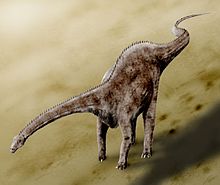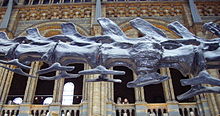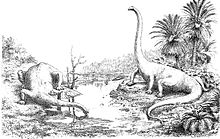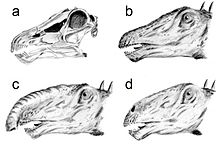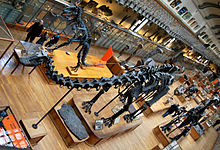
Diplodocus
About this schools Wikipedia selection
SOS Children, which runs nearly 200 sos schools in the developing world, organised this selection. SOS mothers each look after a a family of sponsored children.
| Diplodocus Temporal range: Late Jurassic, 154–150Ma |
|
|---|---|
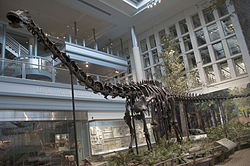 |
|
| Mounted D. carnegii holotype skeleton, Carnegie Museum of Natural History | |
| Scientific classification |
|
| Kingdom: | Animalia |
| Phylum: | Chordata |
| Class: | Reptilia |
| Order: | Saurischia |
| Clade: | †Sauropodomorpha |
| Clade: | †Sauropoda |
| Family: | †Diplodocidae |
| Subfamily: | †Diplodocinae |
| Genus: | †Diplodocus Marsh, 1878 |
| Type species | |
| Diplodocus longus Marsh, 1878 |
|
| Species | |
|
D. longus Marsh, 1878 |
|
| Synonyms | |
|
Seismosaurus Gillette, 1991 |
|
Diplodocus (pron.: / d ɪ ˈ p l ɒ d ə k ə s /, / d aɪ ˈ p l ɒ d ə k ə s /, or / ˌ d ɪ p l oʊ ˈ d oʊ k ə s /) is an extinct genus of diplodocid sauropod dinosaur whose fossils were first discovered in 1877 by S. W. Williston. The generic name, coined by Othniel Charles Marsh in 1878, is a Neo-Latin term derived from Greek διπλόος (diploos) "double" and δοκός (dokos) "beam", in reference to its double-beamed chevron bones located in the underside of the tail. These bones were initially believed to be unique to Diplodocus; however, they have since then been discovered in other members of the diplodocid family and in non-diplodocid sauropods such as Mamenchisaurus.
It lived in what is now western North America at the end of the Jurassic Period. Diplodocus is one of the more common dinosaur fossils found in the Upper Morrison Formation, a sequence of shallow marine and alluvial sediments deposited about 155 to 148 million years ago, in what is now termed the Kimmeridgian and Tithonian stages (Diplodocus itself ranged from about 154 to 150 million years ago). The Morrison Formation records an environment and time dominated by gigantic sauropod dinosaurs such as Camarasaurus, Barosaurus, Apatosaurus and Brachiosaurus.
Diplodocus is among the most easily identifiable dinosaurs, with its classic dinosaur shape, long neck and tail and four sturdy legs. For many years, it was the longest dinosaur known. Its great size may have been a deterrent to the predators Allosaurus and Ceratosaurus: their remains have been found in the same strata, which suggests they coexisted with Diplodocus.
Description
One of the best-known sauropods, Diplodocus was a very large long-necked quadrupedal animal, with a long, whip-like tail. Its forelimbs were slightly shorter than its hind limbs, resulting in a largely horizontal posture. The long-necked, long-tailed animal with four sturdy legs has been mechanically compared with a suspension bridge. In fact, Diplodocus is the longest dinosaur known from a complete skeleton. The partial remains of D. hallorum have increased the estimated length, though not as much as previously thought; when first described in 1991, discoverer David Gillette calculated it may have been up to 54 m (177 ft) long, making it the longest known dinosaur (excluding those known from exceedingly poor remains, such as Amphicoelias). Some weight estimates ranged as high as 113 tons (125 US short tons). The estimated length was later revised downward to 33 metres (108 ft) based on findings that show that Gillette had originally misplaced vertebrae 12–19 at vertebrae 20–27. The nearly-complete Diplodocus skeleton at the Carnegie Museum of Natural History in Pittsburgh, Pennsylvania, on which estimates of Seismosaurus are based, also was found to have had its 13th tail vertebra come from another dinosaur, throwing size estimates for Seismosaurus further off. While dinosaurs such as Supersaurus were probably longer, fossil remains of these animals are only fragmentary. Modern mass estimates for Diplodocus (exclusive of D. hallorum) have tended to be in the 10 to 16 tonne (11–17.6 ton) range: 10 tonnes (11 tons); 11.5 tonnes (12.7 tons); 12.7 tonnes (14 tons); and 16 tonnes (17.6 tons).
The skull of Diplodocus was very small, compared with the size of the animal, which could reach up to 35 m (115 ft), of which over 6 m (20 ft) was neck. Diplodocus had small, 'peg'-like teeth that pointed forward and were only present in the anterior sections of the jaws. Its braincase was small. The neck was composed of at least fifteen vertebrae and is now believed to have been generally held parallel to the ground and unable to have been elevated much past horizontal.
Diplodocus had an extremely long tail, composed of about 80 caudal vertebrae, which is almost double the number some of the earlier sauropods had in their tails (such as Shunosaurus with 43), and far more than contemporaneous macronarians had (such as Camarasaurus with 53). There has been speculation as to whether it may have had a defensive or noisemaking (by cracking it like a coachwhip) function. The tail may have served as a counterbalance for the neck. The middle part of the tail had 'double beams' (oddly shaped bones on the underside, which gave Diplodocus its name). They may have provided support for the vertebrae, or perhaps prevented the blood vessels from being crushed if the animal's heavy tail pressed against the ground. These 'double beams' are also seen in some related dinosaurs.
Like other sauropods, the manus (front "feet") of Diplodocus were highly modified, with the finger and hand bones arranged into a vertical column, horseshoe-shaped in cross section. Diplodocus lacked claws on all but one digit of the front limb, and this claw was unusually large relative to other sauropods, flattened from side to side, and detached from the bones of the hand. The function of this unusually specialized claw is unknown.
Discovery and species
Several species of Diplodocus were described between 1878 and 1924. The first skeleton was found at Cañon City, Colorado by Benjamin Mudge and Samuel Wendell Williston in 1877, and was named Diplodocus longus ('long double-beam'), by paleontologist Othniel Charles Marsh in 1878. Diplodocus remains have since been found in the Morrison Formation of the western U.S. States of Colorado, Utah, Montana and Wyoming. Fossils of this animal are common, except for the skull, which is often missing from otherwise complete skeletons. Although not the type species, D. carnegii is the most completely known and most famous due to the large number of casts of its skeleton in museums around the world.
The two Morrison Formation sauropod genera Diplodocus and Barosaurus had very similar limb bones. In the past, many isolated limb bones were automatically attributed to Diplodocus but may, in fact, have belonged to Barosaurus. Fossil remains of Diplodocus have been recovered from stratigraphic zone 5 of the Morrison Formation.
Valid species
- D. longus, the type species, is known from two skulls and a caudal series from the Morrison Formation of Colorado and Utah.
- D. carnegii (also spelled D. carnegiei), named after Andrew Carnegie, is the best known, mainly due to a near-complete skeleton collected by Jacob Wortman, of the Carnegie Museum of Natural History in Pittsburgh, Pennsylvania and described and named by John Bell Hatcher in 1901.
- D. hayi, known from a partial skeleton discovered by William H. Utterback in 1902 near Sheridan, Wyoming, was described in 1924.
- D. hallorum, first described in 1991 by Gillette as Seismosaurus halli from a partial skeleton comprising vertebrae, pelvis and ribs. George Olshevsky later attempted to emend the name as S. hallorum, citing incorrect grammar on the part of the original authors, a recommendation that has been followed by others, including Carpenter (2006). In 2004, a presentation at the annual conference of the Geological Society of America made a case for Seismosaurus being a junior synonym of Diplodocus. This was followed by a much more detailed publication in 2006, which not only renamed the species Diplodocus hallorum, but also speculated that it could prove to be the same as D. longus. The position that D. hallorum should be regarded as a specimen of D. longus was also taken by the authors of a redescription of Supersaurus, refuting a previous hypothesis that Seismosaurus and Supersaurus were the same.
Nomina dubia (doubtful species)
- D. lacustris is a nomen dubium, named by Marsh in 1884, from remains of a smaller animal from Morrison, Colorado. These remains are now believed to have been from an immature animal, rather than from a separate species.
Paleobiology
Due to a wealth of skeletal remains, Diplodocus is one of the best-studied dinosaurs. Many aspects of its lifestyle have been subjects of various theories over the years.
Habitat
Marsh and then Hatcher assumed the animal was aquatic, because of the position of its nasal openings at the apex of the cranium. Similar aquatic behaviour was commonly depicted for other large sauropods such as Brachiosaurus and Apatosaurus. However, a 1951 study by Kenneth A. Kermack indicates that sauropods probably could not have breathed through their nostrils when the rest of the body was submerged, as the water pressure on the chest wall would be too great. Since the 1970s, general consensus has the sauropods as firmly terrestrial animals, browsing on trees, ferns and bushes.
Posture
The depiction of Diplodocus posture has changed considerably over the years. For instance, a classic 1910 reconstruction by Oliver P. Hay depicts two Diplodocus with splayed lizard-like limbs on the banks of a river. Hay argued that Diplodocus had a sprawling, lizard-like gait with widely splayed legs, and was supported by Gustav Tornier. However, this hypothesis was contested by William Jacob Holland, who demonstrated that a sprawling Diplodocus would have needed a trench to pull its belly through. Finds of sauropod footprints in the 1930s eventually put Hay's theory to rest.
Later, diplodocids were often portrayed with their necks held high up in the air, allowing them to graze from tall trees. Studies using computer models have shown that neutral posture of the neck was horizontal, rather than vertical, and scientists such as Kent Stephens have used this to argue that sauropods including Diplodocus did not raise their heads much above shoulder level. However, subsequent studies demonstrated that all tetrapods appear to hold their necks at the maximum possible vertical extension when in a normal, alert posture, and argued that the same would hold true for sauropods barring any unknown, unique characteristics that set the soft tissue anatomy of their necks apart from other animals. One of the sauropod models in this study was Diplodocus, which they found would have held its neck at about a 45 degree angle with the head pointed downwards in a resting posture.
As with the related genus Barosaurus, the very long neck of Diplodocus is the source of much controversy among scientists. A 1992 Columbia University study of Diplodocid neck structure indicated that the longest necks would have required a 1.6 ton heart — a tenth of the animal's body weight. The study proposed that animals like these would have had rudimentary auxiliary 'hearts' in their necks, whose only purpose was to pump blood up to the next 'heart'.
While the long neck has traditionally been interpreted as a feeding adaptation, it was also suggested that the oversized neck of Diplodocus and its relatives may have been primarily a sexual display, with any other feeding benefits coming second. However, a 2011 study refuted this idea in detail.
Diet
Diplodocus has highly unusual teeth compared to other sauropods. The crowns are long and slender, elliptical in cross-section, while the apex forms a blunt triangular point. The most prominent wear facet is on the apex, though unlike all other wear patterns observed within sauropods, Diplodocus wear patterns are on the labial (cheek) side of both the upper and lower teeth. What this means is Diplodocus and other diplodocids had a radically different feeding mechanism than other sauropods. Unilateral branch stripping is the most likely feeding behaviour of Diplodocus, as it explains the unusual wear patterns of the teeth (coming from tooth–food contact). In unilateral branch stripping, one tooth row would have been used to strip foliage from the stem, while the other would act as a guide and stabilizer. With the elongated preorbital (in front of the eyes) region of the skull, longer portions of stems could be stripped in a single action. Also the palinal (backwards) motion of the lower jaws could have contributed two significant roles to feeding behaviour: 1) an increased gape, and 2) allowed fine adjustments of the relative positions of the tooth rows, creating a smooth stripping action.
With a laterally and dorsoventrally flexible neck, and the possibility of using its tail and rearing up on its hind limbs (tripodal ability), Diplodocus would have had the ability to browse at many levels (low, medium, and high), up to approximately 10 metres (33 ft) from the ground. The neck's range of movement would have also allowed the head to graze below the level of the body, leading some scientists to speculate on whether Diplodocus grazed on submerged water plants, from riverbanks. This concept of the feeding posture is supported by the relative lengths of front and hind limbs. Furthermore, its peglike teeth may have been used for eating soft water plants.
In 2010, Whitlock et al. described a juvenile skull of Diplodocus (CM 11255) that differs greatly from adult skulls of the same genus: its snout is not blunt, and the teeth are not confined to the front of the snout. These differences suggest that adults and juveniles were feeding differently. Such an ecological difference between adults and juveniles had not been previously observed in sauropodomorphs.
Other anatomical aspects
The head of Diplodocus has been widely depicted with the nostrils on top due to the position of the nasal openings at the apex of the skull. There has been speculation over whether such a configuration meant that Diplodocus may have had a trunk. A 2006 study surmised there was no paleoneuroanatomical evidence for a trunk. It noted that the facial nerve in an animal with a trunk, such as an elephant, is large as it innervates the trunk. The evidence suggests that the facial nerve is very small in Diplodocus. Studies by Lawrence Witmer (2001) indicated that, while the nasal openings were high on the head, the actual, fleshy nostrils were situated much lower down on the snout.
Recent discoveries have suggested that Diplodocus and other diplodocids may have had narrow, pointed keratinous spines lining their back, much like those on an iguana. This radically different look has been incorporated into recent reconstructions, notably Walking with Dinosaurs. It is unknown exactly how many diplodocids had this trait, and whether it was present in other sauropods.
Reproduction and growth
While there is no evidence for Diplodocus nesting habits, other sauropods such as the titanosaurian Saltasaurus have been associated with nesting sites. The titanosaurian nesting sites indicate that may have laid their eggs communally over a large area in many shallow pits, each covered with vegetation. It is possible that Diplodocus may have done the same. The documentary Walking with Dinosaurs portrayed a mother Diplodocus using an ovipositor to lay eggs, but it was pure speculation on the part of the documentary.
Based on a number of bone histology studies, Diplodocus, along with other sauropods, grew at a very fast rate, reaching sexual maturity at just over a decade, and continued to grow throughout their lives. Previous thinking held that sauropods would keep growing slowly throughout their lifetime, taking decades to reach maturity.
Daily activity patterns
Comparisons between the scleral rings of Diplodocus and modern birds and reptiles suggest that it may have been cathemeral, active throughout the day at short intervals.
Classification
Diplodocus is both the type genus of, and gives its name to Diplodocidae, the family to which it belongs. Members of this family, while still massive, are of a markedly more slender build when compared with other sauropods, such as the titanosaurs and brachiosaurs. All are characterised by long necks and tails and a horizontal posture, with forelimbs shorter than hindlimbs. Diplodocids flourished in the Late Jurassic of North America and possibly Africa.
A subfamily, Diplodocinae, was erected to include Diplodocus and its closest relatives, including Barosaurus. More distantly related is the contemporaneous Apatosaurus, which is still considered a diplodocid although not a diplodocine, as it is a member of the subfamily Apatosaurinae. The Portuguese Dinheirosaurus and the African Tornieria have also been identified as close relatives of Diplodocus by some authors.
The Diplodocoidea comprises the diplodocids, as well as dicraeosaurids, rebbachisaurids, Suuwassea, Amphicoelias and possibly Haplocanthosaurus, and/or the nemegtosaurids. This clade is the sister group to, Camarasaurus, brachiosaurids and titanosaurians; the Macronaria.
In popular culture
Diplodocus has been a famous and much-depicted dinosaur as it has been on display in more places than any other sauropod dinosaur. Much of this has probably been due to its wealth of skeletal remains and former status as the longest dinosaur. However, the donation of many mounted skeletal casts by industrialist Andrew Carnegie to potentates around the world at the beginning of the twentieth century did much to familiarize it to people worldwide. Casts of Diplodocus skeletons are still displayed in many museums worldwide, including an unusual D. hayi in the Houston Museum of Natural Science, and D. carnegii in a number of institutions.
This includes donations by Carnegie or his trust to:
- The Carnegie Museum of Natural History in Pittsburgh (original, unveiled in 1907)
- The Natural History Museum in London (replica, unveiled on 12 May 1905)
- The Museum für Naturkunde in Berlin, Germany (replica, unveiled in early May, 1908)
- The National Natural History Museum in Paris, France (replica, unveiled on 15 June 1908)
- The Natural History Museum in Vienna, Austria (replica, unveiled in 1909)
- The Museum for Paleontology and Geology in Bologna, Italy (replica, unveiled in 1909). Skulls from this cast (i.e., 'second-generation') are on display in museums in Milan and Naples.
- The Zoological Museum of the Russian Academy of Sciences in St. Petersburg, Russia (replica, unveiled in 1910)
- The Museo de la Plata in La Plata near Buenos Aires, Argentina (replica, unveiled in 1912)
- The National Natural History Museum in Madrid, Spain (replica, unveiled in November 1913)
- The Museo de Paleontología in Mexico City (replica, unveiled in 1930)
- The Paleontological Museum in Munich, Germany (replica, donated in 1932 and still unmounted)
This project, along with its association with 'big science', philanthropism and capitalism, drew much public attention in Europe. The German satirical weekly Kladderadatsch devoted a poem to the dinosaur:
[...] Auch ein viel älterer Herr noch muß
Den Wanderburschen spielen
Er ist genannt Diplodocus‚ und zählt zu den Fossilen
Herr Carnegie verpackt ihn froh
In riesengroße Archen
Und schickt als Geschenk ihn so
An mehrere Monarchen [...]
(Translation: [...] But even a much older gent • Sees itself forced to wander • Goes by the name Diplodocus • And belongs among the fossils • Mr. Carnegie packs him joyfully • In giant arcs • And sends him as gift this way • To multiple monarchs [...]) "Le diplodocus" became a generic term for sauropods in French, much as "brontosaur" is in English.
A further D. carnegii is on display at the Field Museum of Natural History in Chicago. Additionally, D. longus is displayed the Senckenberg Museum in Frankfurt (a skeleton made up of several specimens, donated in 1907 by the American Museum of Natural History), Germany. A mounted and more complete skeleton of D. longus is at the Smithsonian National Museum of Natural History in Washington, D.C., while a mounted skeleton of D. hallorum (formerly Seismosaurus), which may be the same as D. longus, can be found at the New Mexico Museum of Natural History and Science.
Diplodocus has been a frequent subject in dinosaur films, both factual and fictional. It was featured in the second episode of the award-winning BBC television series Walking with Dinosaurs. The episode "Time of the Titans" follows the life of a simulated Diplodocus 152 million years ago. In literature, James A. Michener's book Centennial has a chapter devoted to Diplodocus, narrating the life and death of one individual.
